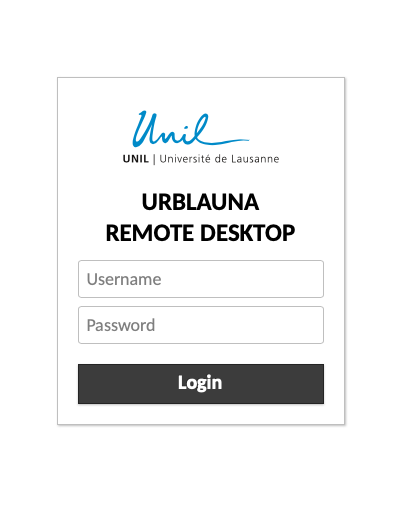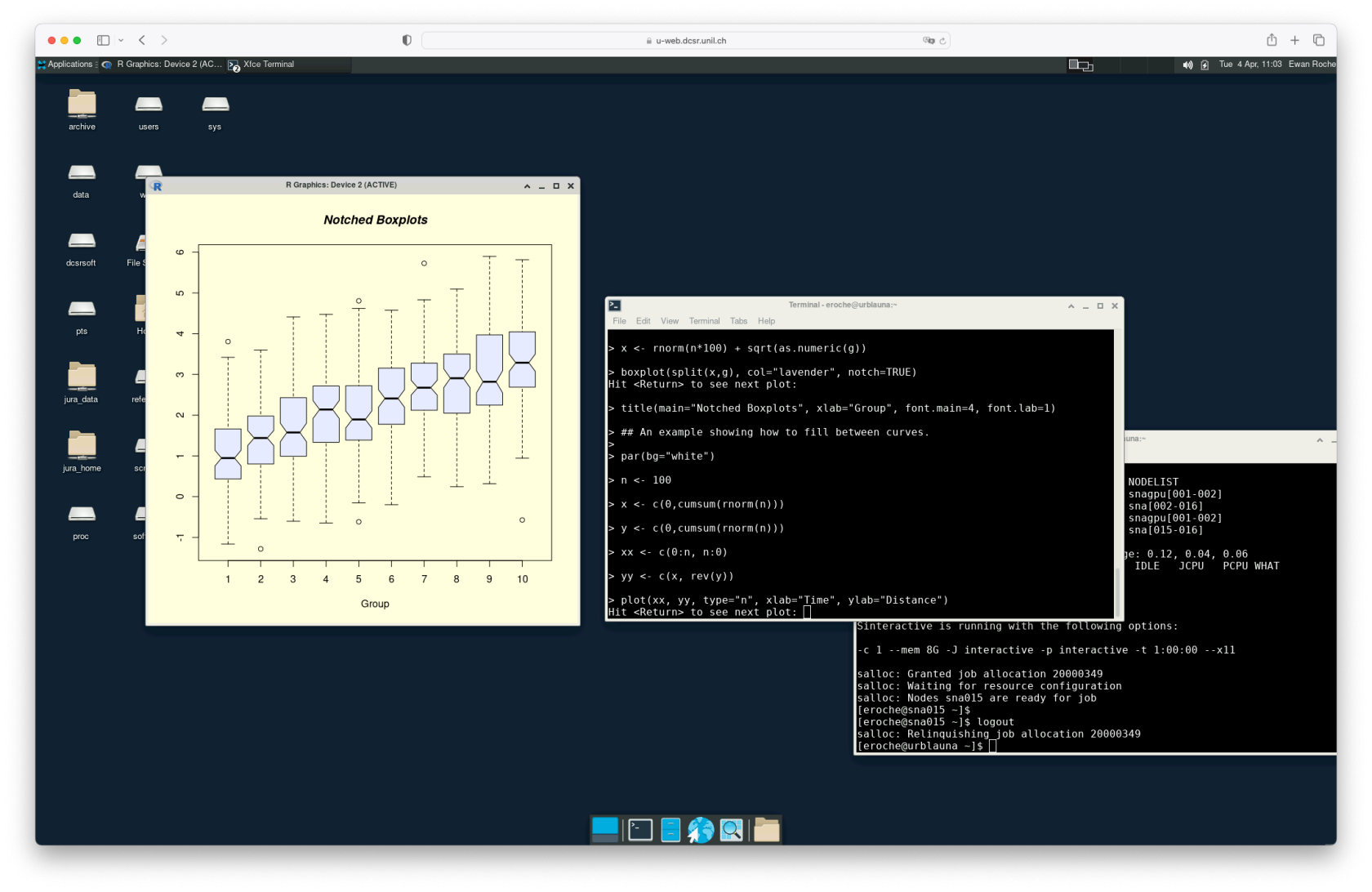Urblauna migration
Urblauna
Urblauna is the new UNIL cluster for sensitive data and will replace the Jura cluster.
stockage-horus is the name used for the Jura cluster when connecting from the CHUV.
Note: "HORUS" is an acronym for HOspital Research Unified data and analytics Services
Documentation
As well as this page there is documentation at:
https://wiki.unil.ch/ci/books/high-performance-computing-hpc/page/urblauna-access-and-data-transfer
https://wiki.unil.ch/ci/books/high-performance-computing-hpc/page/jura-to-urblauna-migration
https://wiki.unil.ch/ci/books/high-performance-computing-hpc/page/urblauna-guacamole-rdp-issues
Nearly all the documentation for Curnagl is also applicable - see the HPC Wiki
The introductory course for using the clusters is available HERE
The slides for our other courses can be consulted HERE
These courses are next planned for the 13th, 14th and 15th of June 2023 and take place in the Biophore auditorium
Support
Please contact the DCSR via helpdesk@unil.ch and start the mail subject with "DCSR Urblauna"
Do not send mails to dcsr-support - they will be ignored.
Specifications
- 18 compute nodes
- 48 cores / 1 TB memory per node
- 2 nodes with NVidia A100 GPUs
- 1PB /data filesystem
- 75TB SSD based /scratch
Total cores: 864
Total memory: 18TB
Memory to core ratio: 21 GB/core
For those of you have already used Curnagl then things will be very familiar.
If the initial resources are found to be insufficient then more capacity can be easily added.
An Urblauna looks like:
How to connect
For Jura the connection method is different depending on if one connects from the CHUV or the UNIL networks - for Urblauna it's the same for everyone.
The SSH and Web interfaces can be used simultaneously.
Two Factor Authentication
You should have received a QR code which allows you to setup the 2FA - if you lose your code then let us know and we will generate a new one for you.
SSH
% ssh ulambda@u-ssh.dcsr.unil.ch
(ulambda@u-ssh.dcsr.unil.ch) Password:
(ulambda@u-ssh.dcsr.unil.ch) Verification code:
Last login: Wed Jan 18 13:25:46 2023 from 130.223.123.456
[ulambda@urblauna ~]$
The 2FA code is cached for 1 hour in case that you connect again.
X11 Forwarding and SSH tunnels are blocked as is SCP
Web
Go to u-web.dcsr.unil.ch and you will be asked for your username and password followed by the 2FA code:
This will send you to a web based graphical desktop that should be familiar for those who already use jura.dcsr.unil.ch
Note than until now the CHUV users did not have this as a connection option.
Data Transfer
The principle method to get data in/out of Urblauna is using the SFTP protocol
On Urblauna your /scratch/<username> space is used as the buffer when transferring data.
% sftp ulambda@u-sftp.dcsr.unil.ch
(ulambda@u-sftp.dcsr.unil.ch) Password:
(ulambda@u-sftp.dcsr.unil.ch) Verification code:
Connected to u-sftp.dcsr.unil.ch.
sftp> pwd
Remote working directory: /ulambda
sftp> put mydata.tar.gz
Uploading mydata.tar.gz to /ulambda/mydata.tar.gz
The file will then be visible from urblauna at /scratch/ulambda/mydata.tar.gz
For graphical clients such as Filezilla you need to use the interactive login type so as to be able to enter the 2FA code.
Coming soon
There will be an SFTP endpoint u-archive.dcsr.unil.ch that will allow transfer to the /archive filesystem without 2FA from specific IP addresses at the CHUV.
This service will be what stockage-horus was originally supposed to be!
This is on request and must be validated by the CHUV security team.
What's new
There are a number of changes between Jura and Urblauna that you need to be aware of:
CPUs
The nodes each have two AMD Zen3 CPUs with 24 cores for a total of 48 cores per node.
In your jobs please ask for the following core counts:
- 1
- 2
- 4
- 8
- 12
- 24
- 48
Do not ask for core counts like 20 / 32 / 40 as this makes no sense given the underlying architecture. We recommend running scaling tests to find the optimal level of parallelism for multi-threaded codes.
Unlike for Jura all the CPUs are identical so all nodes will provide the same performance.
GPUs
There are two GPU equiped nodes in Urblauna and each A100 card has been partitioned so as to provide a total of 8 GPUs with 20GB of memory.
To request a GPU use the --gres Slurm directive
#SBATCH --gres gpu:1
Or interactively with Sinteractive and the -G option
$ Sinteractive -G 1
Sinteractive is running with the following options:
--gres=gpu:1 -c 1 --mem 8G -J interactive -p interactive -t 1:00:00
salloc: Granted job allocation 20000394
salloc: Waiting for resource configuration
salloc: Nodes snagpu001 are ready for job
$ nvidia-smi
..
+-----------------------------------------------------------------------------+
| MIG devices: |
+------------------+----------------------+-----------+-----------------------+
| GPU GI CI MIG | Memory-Usage | Vol| Shared |
| ID ID Dev | BAR1-Usage | SM Unc| CE ENC DEC OFA JPG|
| | | ECC| |
|==================+======================+===========+=======================|
| 0 1 0 0 | 19MiB / 19968MiB | 42 0 | 3 0 2 0 0 |
| | 0MiB / 32767MiB | | |
+------------------+----------------------+-----------+-----------------------+
+-----------------------------------------------------------------------------+
| Processes: |
| GPU GI CI PID Type Process name GPU Memory |
| ID ID Usage |
|=============================================================================|
| No running processes found |
+-----------------------------------------------------------------------------+
MPI
This is now possible... Ask us for more details if needed.
/data
The /data filesystem is structured in the same way as on Jura but it is not the same filesystem
This space is on reliable storage but there are no backups or snapshots.
The initial quotas are the same as on Jura - if you wish to increase the limit then just ask us. With 1PB available all resonable requests will be accepted.
The Jura /data filesystem is available in read-only at /jura_data
/scratch
Unlike on Jura /scratch is now organised per user as on Curnagl and as it is considered as temporary space there is no fee associated.
There are no quotas but in case of the utilisation being greater that 90% then files older than 2 weeks will be removed automatically.
/users
The /users home directory filesystem is also new - the Jura home directories can be accessed in read-only at /jura_home.
/work
The Curnagl /work filesystem is visible in read-only from inside Urblauna. This is very useful for being able to install software on an Internet connected system.
/reference
This is intended to host widely used datasets
The /db set of biological databases can be found at /reference/bio_db/
/archive
This is exactly the same /archive as on Jura so there is nothing to do!
The DCSR software stack
This is now the default stack and is identical to Curnagl. It is still possible to use the old Vital-IT /software but this is deprecated and no support can be provided.
For how to do this see the documentation at Old software stack
Note: The version of the DCSR software stack currently available on Jura (source /dcsrsoft/spack/bin/setup_dcsrsoft) is one release behind that of Curnagl/Urblauna. To have the same stack you can use the dcsrsoft use old command:
[ulambda@urblauna ~]$ dcsrsoft use old
Switching to the old software stack
There's lots of information on how to use this in our introductory course
Installing your own software
We encourage you to ask for a project on Curnagl (HPC normal data) which will allow you to install tools and then be able to use them directly inside Urblauna.
See the documentation for further details
For those who use Conda don't forget to make sure that all the directories are in your project /work space
https://wiki.unil.ch/ci/books/high-performance-computing-hpc/page/using-conda-and-anaconda
nano .condarc
pkgs_dirs:
- /work/path/to/my/project/space
envs_dirs:
- /work/path/to/my/project/space
For R packages it's easy to set an alternative library location:
echo 'R_LIBS_USER=/work/path/to/project/Rlib' > ~/.Renviron
This will need to be run on both Curnagl and Urblauna and will allow you to install packages when connected to the internet and run them inside the air gapped environment.
Jura decommissioning
Urblauna provides a generational leap in performance and capacity compared to Jura so we hope that the interest to migrate is obvious.
- On Sept 30 the queuing system and the compute nodes will be stopped.
- On Oct 31 /data will be put in read only
- On Nov 30 the system will be definitely stopped
If you need help transferring your workflows from Jura to Urblauna then just ask us!



